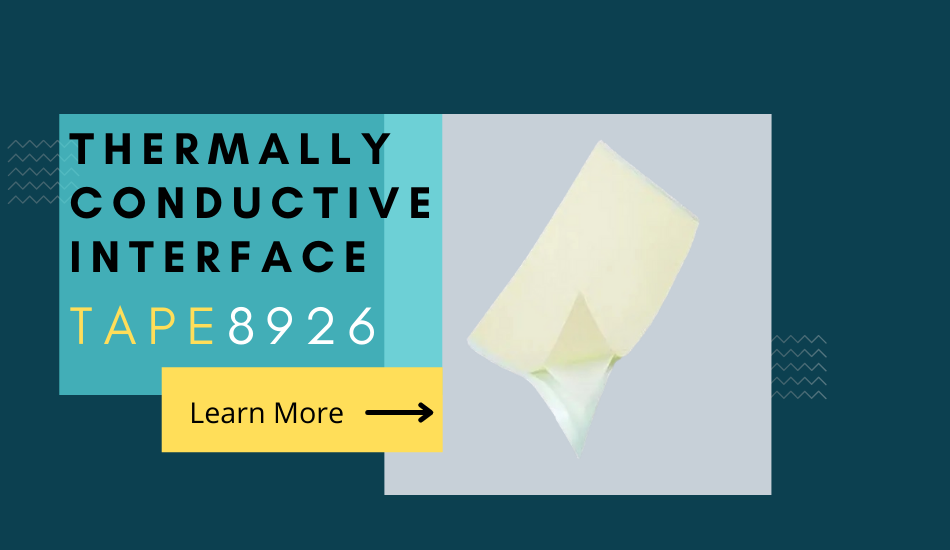It is really difficult for many people to find a suitable tape that can do the task of adhesion to provide safety and conduction.
If you are also facing issues like this then read further to find how you can find the right conductive tape for your application too!
What is Thermally Conductive Interface Tape?
The thermally conductive tapes are usually made with acrylic and silicone-based thermal fillers. These are coated with acrylic and silicone to support surfaces like polyimide films, fiberglass, and aluminum foils. These substrates are used to provide additional stability that comes in handy while using and handling the tape.
Why Are Thermal Conductive Tapes Ideal to Use?
The conductive tapes are very useful in certain cases. That requires an additional thermal solution to keep the device running and in good condition.
For example, the 3M thermally conductive interface tape 8926 creates a path to dissipate the heat away from the heat-generating components to a heat sink or some other area with components that are not heat sensitive.
Similarly, the interface tapes also create a better surface contact between two layers. It also reduces the thermal resistance from the interface joints and provides further cooling to the device. The 3M thermally conductive interface tape 8926, e.g., has a very good tack property that delivers high strength bind between two components.
The high-strength tack also eliminates the need for mechanical fasteners like screws and bolts. This proves further useful by keeping the device lightweight.
How to Choose the Right Type of Thermally Conductive Interface Tapes?
You should first look at the requirements of your application before looking for the options. There are some basic properties of every conductive tape and then the secondary properties are the ones that determine if a certain type of conductive tape is suitable for some application or not.
These traits can be high-grade adhesion to provide mechanical strength. The reliability feature provides better and long-term performance without any reworking. Also, the 3M tapes are adverse to extreme conditions and can be used in rugged applications as well without worrying about safety concerns.
Another secondary trait can be the ability to work with different substrates that are uneven or unfinished. These are extremely lightweight tapes and make devices additionally aesthetic like wearable, it keeps the device slim and compact without compromising the quality.
Also look at the ratings for flammability, ambient working conditions, and amount of heat that is conducted at any given time.
Smart thin and skin line silicone-based materials are proving to be tremendously interesting as these can easily be used in certain types of applications like soft robotics, wearable devices, and other bendy and stretchable materials.
When looking for conductive tapes always start with the amount of heat that the device will generate?
Then what are the EMI issues and challenges you are facing, and the chances of combining two or more TIM solutions? Choosing the right product looks for the thermal conductivity and resistance, viscosity, and ease of application.
The mechanical properties of the material are some more features to pay attention to while looking for something that will give a long-term performance.
Why 3M Thermally Conductive Interface Tape 8926 is Highly in Demand?
The 3M created series specifically for the 8926 was specifically designed keeping the requirements of the electronic industry in mind. It also contains thermally conductive particles for conduction and flame resistant properties as well.
The 3M 8926 comes with ease of handling. It is very easy to use on surfaces and the workability is also excellent. It is customizable as well-meaning it can be die-cut and converted into custom shapes and sizes tailored according to the size required by the design of the device.
Benefits of 3M 8926 Interface Tape
One of its several benefits is that it offers higher flexibility than other thermally conductive interface tapes.
It has higher adhesion than other tapes with similar thicknesses; this enhances the design and assembly flexibility.
Its thermal conductivity is excellent (>1.5W/m-K)
The dielectric performance upgrades the overall functioning of the device and elongates the life cycle of the product.
It is compatible with such devices that need low thermal impedance.
It can also be used as filler for smaller as well bigger spaces which provide extra protection from vibration and external shock.
Applications for Thermal Conductive Interface Tapes
Lighting
The 3M conductive tapes are used in several applications that involve lighting and other components. The tapes are used to attach the LEDs to the heat sinks to remove the excessive heat from the lights.
Electronics
It is also very useful in consumer electronics as it helps them in keeping lightweight, compact and safe to use.
Batteries
The batteries have several components in them that require combining and the heat in the battery also creates the additional challenge of fire and safety.
Integrated Circuit (IC) Packaging
The IC industry requires thermally conductive tapes. That are useful in keeping the ICs together and providing thermal solutions along with it.
Used as Cooling Device
The thermal tapes are used as additional cooling factors in high-end applications that require more heat dissipation and thermal solution. It can be combined with external components like fans, heat spreaders, and heat pipes.
Conclusion
The conductive interface tapes are designed in such away. That enables them to move the heat from one area to another. These tapes can be customized as well to support die-cutting and cling to surfaces that are not smooth or even. The 3M thermally conductive interface tape 8926 is one of many interface tapes that have very high demand in the current electronic market.
These come in large rolls in various thickness sizes, with high mechanical strength and shock resistance performance. The high tack provides the removal of mechanical fasteners and the peel-stick feature is excellent in handling with ease.

